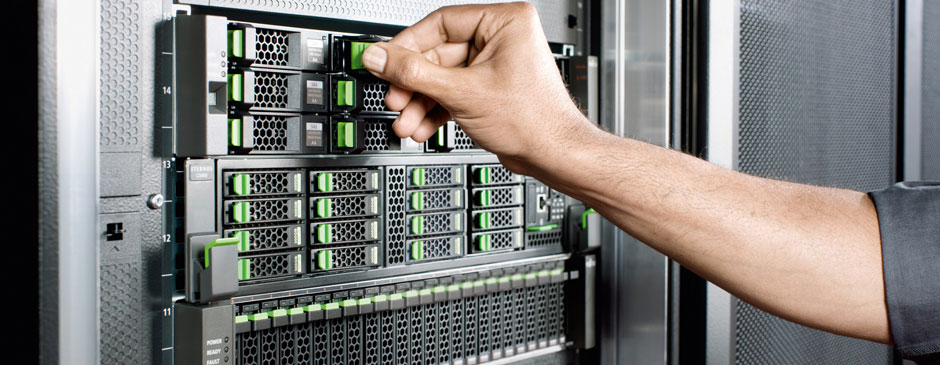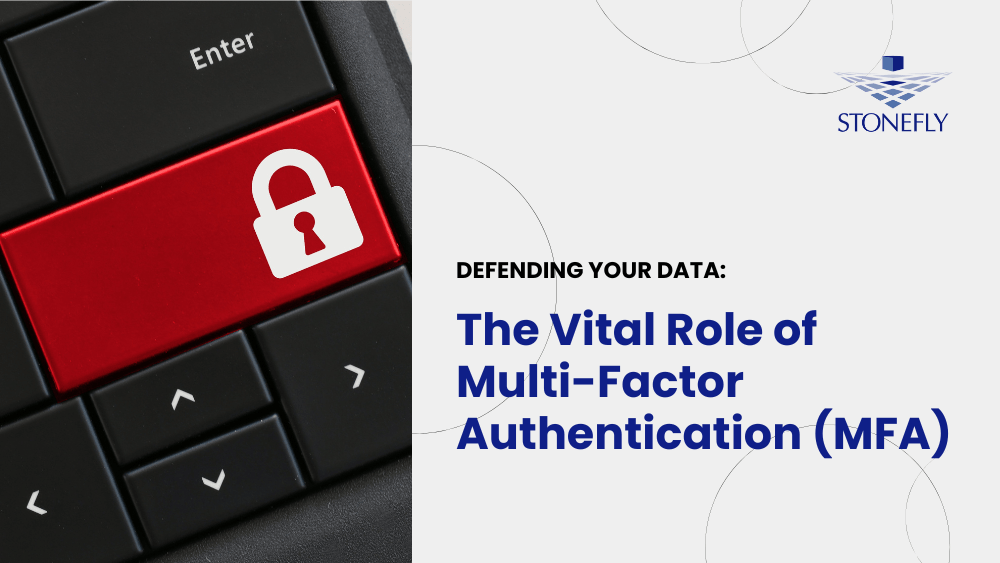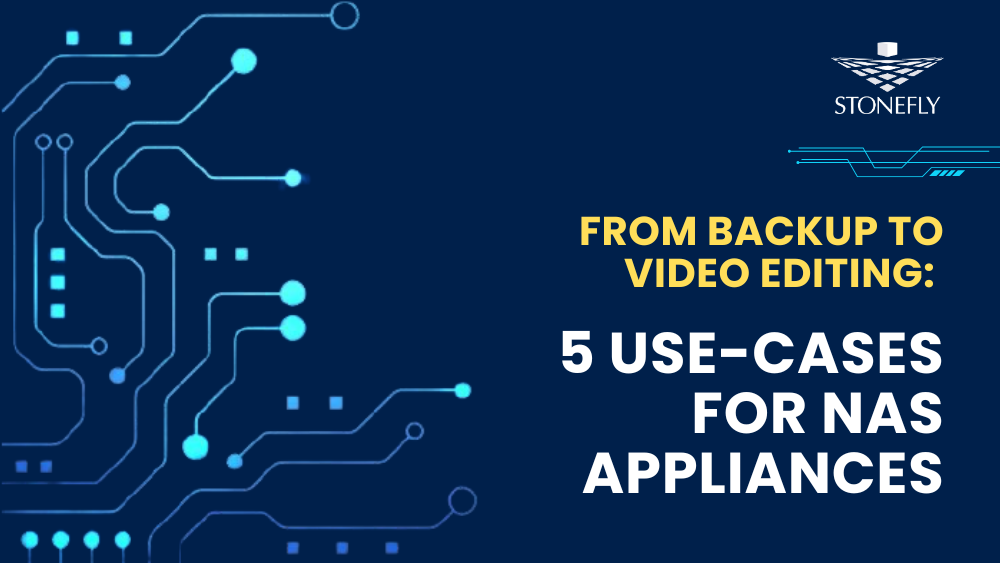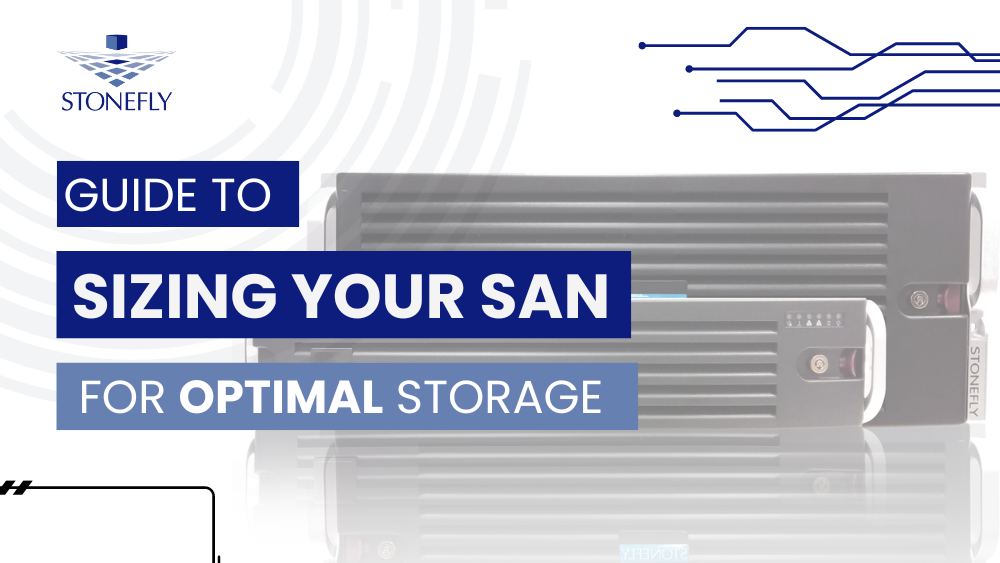Network attached storage provides a scalable, flexible and dynamically upgradeable infrastructure which meets the needs of the fast growing businesses which require exponential growth in the capacity of storing and managing the mission critical unstructured big data.
What is a Network Attached Storage Device?
If you’re confused about “What is NAS storage” here’s a brief explanation:
A network attached storage device is a file level data storage infrastructure which offers virtually unlimited scalability. It consists of appliance nodes which are not just the storage drives but a lot more than that. These are servers which have the ability to store and manage the data along with the ability to provide data services and features in order to assure data protection and security.
It’s a network attached file level data storage. You can store, access and share data in the network attached storage appliance via a configured network using NAS storage protocols: NFS/CIFS and SMB. The network attached storage device is the best option for simplified and effective storage of unstructured big data.
What is Network Attached Storage Used for?
Wondering what is NAS storage used for? To summarize it, a NAS network storage is used for unstructured data storage. This can be surveillance videos, files, backups, snapshots, emails, etc.
The network attached storage is very handy for HPC (High Performance Computing) requirements. NAS appliances can be effectively used for requirements like video data editing and retention in broadcasting environments, video data storage for law enforcement agencies, record maintenance and data analytics for Finance industry, secure and cost effective storage for Healthcare industry etc.
Network attached storage can also be very useful in managing the video surveillance data, media and entertainment industry and also hi tech data coming from body worn cameras which are generating may be more than any other form of video data.
These are some of the leading use cases of network attached storage.
Cloud Storage vs NAS Storage
Cloud based solutions are mostly preferred because of three reasons: Scalability, Data Accessibility and Cost Effectiveness.
When comparing cloud storage solutions with enterprise network attached storage solution; the first question that comes to mind is: “Why should I purchase an appliance instead of setting up storage in a cloud?”
The main benefit is the speed that comes with the network attached storage device and the lack of a third party.
StoneFly’s SSO™ (Super Scale-out) network attached storage delivers scale-out capabilities that enhance performance along with the increased storage space. The SSO™ network attached storage device also supports scale-up for simplified storage environments.
As far as accessibility is concerned, the data stored in the storage appliance can be accessed remotely as long as the appliance is kept on. In order to do so, the IT teams can configure a VPN (Virtual Private Network) / RDP (Remote Desktop Protocol) to enable access to stored data. This delivers the same kind of data accessibility and device independency as cloud based services.
NAS vs RAID – Not an Either/Or Decision
Redundant Array of Independent Disks (RAID) is a hardware configuration used to improve disk performance, and setting up fault-tolerance. Storage expansion units that come with a built-in hardware RAID controller are often referred to as RAID storage arrays or RAID arrays.
RAID leverages data redundancy across multiple drives, depending on the RAID level, to prevent data loss even if a drive or drives fail.
For more about RAID, read What is RAID?
As mentioned above, NAS storage provides scalable file storage to devices connected to the network. While both NAS and RAID are storage technologies, you shouldn’t have to choose between them. A reliable NAS storage infrastructure should have integrated RAID controller to ensure high availability and business continuity.
RAID levels are denoted by a number and determine the performance and redundancy of the NAS RAID storage. High end systems for larger organizations offer a plethora of RAID options that storage administrators can use to meet their file storage capacity, performance and data protection requirements. For example, StoneFly SSO NAS storage, depending on the appliance series and model, are configured with high-performance 12Gb SAS hardware RAID controller with RAID Cache Battery backup that supports RAID Levels 0, 1, 3, 5, 6, 10, 30, 50 and 60.
The Role of Network Attached Storage Device in Work Environment
Network attached storage technology fits perfectly in an office environment that depends on effective data sharing between different workstations and/or departments. Data mobility empowers all processes and slowly contributes to the productivity of the team and the company.
For instance, consider a broadcasting environment. There are multiple sources of image and video data. With a network attached storage device, all of this data can be easily channeled into the desired storage location. It’ll be easier for the resource management department to collect and manage this data. Then, when it comes to the editing part, the video editor won’t have to wait for the data; they’ll access the same storage location and start working. Evidently, the appliance plays a central role in such an environment.
This role of network attached storage technology in inter- and intra-team collaboration makes it very attractive for companies focused on leveraging teamwork for productivity and profitability.
Advantages of NAS Storage
Centralized File Storage Management – Consolidate and simplify file storage and sharing with a centralized NAS storage. By setting up access protocols, you can make sure that all departments and teams have access to important data seamlessly.
Complete Control of Infrastructure – With an on-prem NAS storage, you maintain complete control of your digital assets as opposed to cloud storage where you rely on the CSP and don’t know exactly where the data is stored.
Customize Your Private Cloud – Customize the CPU, system memory, network, and storage capacity of your NAS storage to build a private cloud as per your needs and budget.
Hybrid and Multi-Cloud Storage – Leverage cloud connect services to combine the performance of on-prem NAS storage with the scalability of the cloud to set up a hybrid and multi-cloud storage environment. Facilitate diverse workloads with a unified file storage solution.
Automate Data Management – With data services such as automated hot/cool tiering, automate data transfers between hot-tier storage hosted on SSDs, to cold tier storage using SAS/SATA so that you can ensure effective NAS storage with minimum IT staff intervention and no human error.
Data Protection with Network Attached Storage Device
Immutable Snapshots
Immutable storage snapshots make sure that the snapshots taken once, cannot be edited, deleted or changed. Once a snapshot is taken, it cannot be overridden and it assures data protection.
Write-Once Read-Many (WORM) Volumes
WORM stands for Write Once Read Many. It means once data has been written to WORM volumes, it cannot be edited or modified for the defined retention period. However, it can be read as many times as required. These immutable WORM storage volumes makes sure that even if a ransomware gains access to the corporate network, the critical data stored in them is protected and secure.
Built-in Anti-Malware and Anti-Ransomware
StoneFly’s network attached storage is equipped with anti-malware and anti-ransomware features to make sure that the mission critical data is safe and secure from the cyber-attacks which have become a very common phenomenon today.
Built-in Veeam Agent for Network Attached Storage
StoneFly’s network attached storage comes with a built-in Veeam agent which allows the Veeam users to set up NAS in the cloud.
Network Attached Storage Platform Scales Across All Resources
Each StoneFly scale out network attached storage node supports up-to 256 drives or 2.5 Petabytes (2,560 Terabytes). This can be scaled out to 100s or 1000s of nodes based on-demand. The StoneFly Scale-Out NAS Storage nodes are perfect for managing large quantities of unstructured Object or File Storage within a single global-namespace.
StoneFly’s scale-out network attached storage appliances are designed for markets that require parallel throughput and high bandwidth such as High Performance Computing (HPC) and Big Data, Persistent Storage, Oil and Gas, Media and Entertainment, Education Institutions, Manufacturing Companies and Life Sciences.
*Note: Supported drives may vary depending on appliance series and model. For details, contact StoneFly pre-sales engineers.
When it comes to scalability, StoneFly Network Attached Storage cannot only dynamically scale out but also scale up.
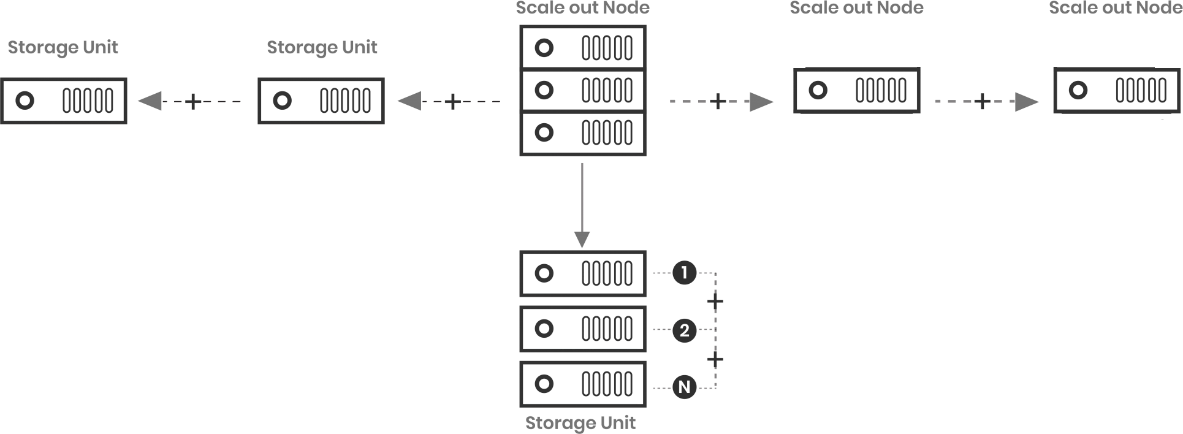
Scale Out
StoneFly network attached storage can be scaled out by adding at least 3 nodes to start with, and it has the ability to add ‘n’ number of nodes as per the requirements of the user. It involves adding extra storage drives, performance and more computing capabilities to the infrastructure dynamically, without any disruption.
Scale Up
It allows the users to add 256 EBOD’s with the support of SAS and SSD’s. It can take storage capacity up to petabytes.
Enterprise-Grade Features of StoneFly Network Attached Storage
StoneFly network attached storage is equipped with a number of a data services and enterprise grade features.
Network Attached Storage Operating System Features
Automated Tiering
StoneFly NAS allows business to define policies that move data between storage repositories, automating & simplifying data management. This automation compliments storage efficiency & reduces the possibility of human-error.
Learn more about Automated Data Tiering.
Built-in Cloud Connect
Our NAS has built-in cloud connect which enables users to have access to cloud storage repositories.
Global Namespace
It has global namespace which makes the storage as accessible and convenient as the local drives on a computer.
Synchronous and Asynchronous Replication
This allows the user to get the real time and scheduled replication of data so that the data security, availability and accessibility is enhanced.
Learn more about Storage Replication Techniques.
Auto Rebalance
This helps in managing the large volumes of data in an effective and efficient manner. The distribution of data across the infrastructure makes it more effective and usable for all the users.
Parallel Throughput
Parallel throughput allows multiple I/O operations to be carried out at the same time. It enhances the productivity of the infrastructure.
Hardware Features of Network Attached Storage
RAID Controller
The NAS appliance has built-in 12GB SAS hardware RAID controller capable of 0,1,3,5,6,10,30,50, and 60 RAID levels. This makes the data storage fault tolerant and reliable.
Redundant Power Supplies
Another fascinating hardware feature to ensure data protection is the redundant power supplies which are hot swappable. It makes sure that even if one power supply of the appliance fails, the other one takes its place and keeps the data available while you fix it.
To know more about StoneFly’s network attached storage, you can go to Enterprise NAS Storage.
Conclusion
StoneFly, through its scale-out network attached storage, offers a solution which requires the least commitment from customers. The network attached storage solution provides the customers with all the freedom in choosing the amount of storage they need and paying only for the amount of storage used.
Contact Us Today!
Email: sales@staging.stonefly.com
Phone: +1 510 265 1616
Website: www.stonefly.com | www.iscsi.com
Connect with Us on Our Social Media
Twitter: @stoneflyinc
Facebook: facebook.com/stoneflyinc
Youtube: youtube.com/stoneflyinc
Linkedin: linkedin.com/company/stonefly-networks
